
A submachine gun (SMG) is a magazine-fed automatic carbine designed to fire handgun cartridges. The term "submachine gun" was coined by John T. Thompson, the inventor of the Thompson submachine gun, to describe its design concept as an automatic firearm with notably less firepower than a machine gun. As a machine gun must fire rifle cartridges to be classified as such, submachine guns are not considered machine guns.
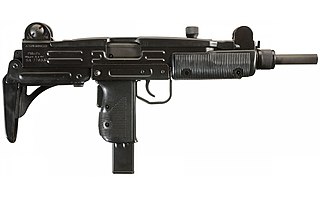
The Uzi is a family of Israeli open-bolt, blowback-operated submachine guns and machine pistols first designed by Major Uziel "Uzi" Gal in the late 1940s, shortly after the establishment of the State of Israel. It is one of the first weapons to incorporate a telescoping bolt design, which allows the magazine to be housed in the pistol grip for a shorter weapon.

The Thompson submachine gun is a blowback-operated, selective-fire submachine gun, invented by United States Army brigadier general John T. Thompson in 1918. It was originally designed to break the stalemate of trench warfare of World War I, but early models did not arrive in time for combat.
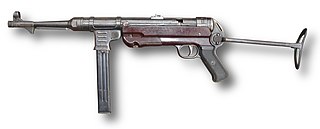
The MP 40 is a submachine gun chambered for the 9×19mm Parabellum cartridge. It was developed in Nazi Germany and used extensively by the Axis powers during World War II.

The STEN is a family of British submachine guns chambered in 9×19mm which were used extensively by British and Commonwealth forces throughout World War II and the Korean War. They had a simple design and very low production cost, making them effective insurgency weapons for resistance groups, and they continue to see usage to this day by irregular military forces. The Sten served as the basis for the Sterling submachine gun, which replaced the Sten in British service until the 1990s, when it, and all other submachine guns, were replaced by the SA80.

The .45 Reising submachine gun was manufactured by Harrington & Richardson (H&R) Arms Company in Worcester, Massachusetts, USA, and was designed and patented by Eugene Reising in 1940. The three versions of the weapon were the Model 50, the folding stock Model 55, and the semiautomatic Model 60 rifle. Over 100,000 Reisings were ordered during World War II, and were initially used by the United States Navy, Marine Corps, and the United States Coast Guard, though some were shipped to Canadian, Soviet, and other allied forces to fight the Axis powers.

The Military Armament Corporation Model 10, officially abbreviated as "M10" or "M-10", and more commonly known as the MAC-10, is a compact, blowback operated machine pistol/submachine gun that was developed by Gordon B. Ingram in 1964. It is chambered in either .45 ACP or 9mm. A two-stage suppressor by Sionics was designed for the MAC-10, which not only abates the noise created but makes it easier to control on full automatic.
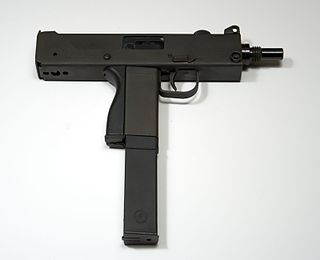
The MAC-11 is a machine pistol/submachine gun developed by American firearm designer Gordon Ingram at the Military Armament Corporation (MAC) during the 1970s in Powder Springs, Georgia, United States. The weapon is a sub-compact version of the Model 10 (MAC-10), and is chambered to fire the smaller .380 ACP round.

The PM-84 Glauberyt is a Polish submachine gun. It is a personal weapon intended for combat and self-defence at ranges up to 150 m with single shot or fully automatic fire mode. It features a compact design, minimum overall dimensions, small weight, very good accuracy, and fire stability. It is designed for heavy weapons platoons personnel and reconnaissance detachments, special anti-terrorist and police troops.

A firearm is said to fire from an open bolt if, when ready to fire, the bolt and working parts are held to the rear of the receiver, with no round in the chamber. When the trigger is actuated, the bolt travels forward, feeds a cartridge from the magazine or belt into the chamber, and fires that cartridge in the same movement. Like any other self-loading design, the action is cycled by the energy released from the propellant, which sends the bolt back to the rear, compressing the mainspring in readiness for firing the next round. In an open-bolt gun firing semi-automatically, the bolt is caught and held at this point by the sear after each shot; and in automatic open-bolt fire, it's caught and held in this manner whenever the trigger is released. In contrast to this, in closed-bolt guns, the trigger and sear do not affect the movement of the bolt directly.
Blowback is a system of operation for self-loading firearms that obtains energy from the motion of the cartridge case as it is pushed to the rear by expanding gas created by the ignition of the propellant charge.

The PM-63 RAK is a Polish 9×18mm submachine gun, designed by Piotr Wilniewczyc in cooperation with Tadeusz Bednarski, Grzegorz Czubak and Marian Wakalski. The RAK combines the characteristics of a self-loading pistol and a fully automatic submachine gun.
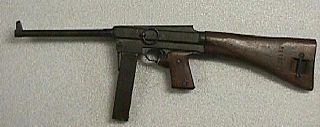
The MAS-38 is a French submachine gun designed in the 1930s and used by French and German forces during the Second World War. It was derived from a small arms development program that took place between 1918 and 1922 under the control of the Service Technique de l'Armement. A submachine gun, a light machine gun and a semiautomatic rifle were developed to replace all the existing small arms. Budgetary pressures resulting from the building of the Maginot Line led to the delay of adoption of these new arms except for the LMG 1924.
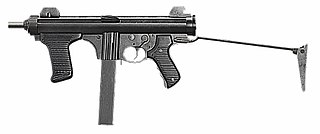
The Beretta M12 is a 9×19mm Parabellum caliber submachine gun designed by Beretta. Production started in 1959, the first users were the Italian Carabinieri, Italian State Police and the Guardia di Finanza, though in limited number, it was only widely issued beginning in 1978, replacing the old Beretta MAB. In 1962 the Italian Army bought a limited number of Franchi LF-57 submachine guns, judged better than the M12 but never issued to the troops, and only in 1992 the M12S2 variant was introduced, in very limited number. The Italian Air Force, instead bought many M12S and M12S2 for the airport security units. However the weapon had a higher initial success in the Arab countries and South America.
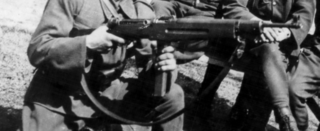
The Danuvia 39M/43M was a Hungarian submachine gun designed by Pál Király in the late 1930s and used during World War II.

The Jatimatic is a Finnish 9×19mm Parabellum submachine gun developed in the late 1970s and early 1980s by Jali Timari. The submachine gun made its debut in 1983. The Jatimatic was manufactured in very limited numbers initially by Tampereen Asepaja Oy of Tampere and later—Oy Golden Gun Ltd. The firearm was designed primarily for police, security forces and armored vehicle crews. It was never adopted into service by the Finnish Defence Forces, although the later GG-95 PDW version was tested by the FDF in the 1990s. In 1986, actor Sylvester Stallone wielded a Jatimatic, fitted with a custom laser sight, while starring in the movie "Cobra", marking the only known use of the weapon in a major Hollywood production.

The Star Z-84 was a Spanish selective-fire submachine gun originally manufactured by the now defunct Star Bonifacio Echeverria, S.A. The Z-84 is a sturdy, well-designed weapon that never saw high production due to politics. Originally manufactured for use by Combat Swimmers, the Z-84 could be used right out of the water without any need to drain the working parts or magazine, known as over-the-beach or OTB capability.

The PP-90 is a Russian 9 mm folding submachine gun, developed by the KBP Instrument Design Bureau in Tula for use with special units of the Russian Ministry of Internal Affairs (MVD). It is designed for close quarters combat, particularly engagements that require the weapon to be deployed rapidly in unusual circumstances.

The Revelli Automatic Machine Gun, official designation FIAT Mod. 1915 and commonly nicknamed the Vilar Perosa, was an Italian portable automatic weapon developed during World War I by the Officine di Villar Perosa.

The Hotchkiss "type Universal" is a submachine gun manufactured in France after World War II. It was originally designed as a semi-automatic police carbine but a full automatic version was made. It fires from a closed bolt. Its most unique feature however is that it folds up into a very compact package and unfolds easily and relatively quickly. The semi-automatic version was exported in very limited numbers to many countries. Many were also exported to Venezuela and Morocco.


















